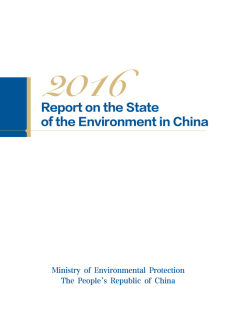2016 is the opening year of the key period for China to build a well-off society in an all-round way, and the crucial year of promoting structural reform. All regions and departments had firmly implemented the decisions and arrangements made by CCCPC and the State Council to scale up China’s Five-in-one general strategy and promote Four-pronged Comprehensive strategy. Efforts have been made to carry out new concept of development. With the improvement of environment as the core, we have focused on solving prominent environmental problems and steadily promote environmental protection in all aspects so as to make substantial progress.
According to the Report, in the 74 cities that subject to the new Ambient Air Quality Standards for the phase I implementation, 74.2% of the days in 2016 saw good or excellent air quality, an increase of 3 percentage points compared with 2015, and the average concentration of fine particles (PM2.5) decreased by 9.7% compared with 2015.
In 338 cities at or above the prefecture-level, 78.8% of the days in 2016 saw good or excellent air quality, 2.1 percentage points higher than what it was in 2015, and 21.2% of days saw air quality worse than the new standard. Precipitation monitoring program was carried out in 474 cities (districts, counties). The mean annual pH value of rainfalls was below 5.6 (acid rain) in 19.8% of the monitored cities, and the average frequency of the acid rain was 12.7%. Acid rain in China is mainly associated with sulfuric acid, and usually spotted in the areas south of the Yangtze River and east of the Yunnan-Guizhou Plateau. For the water environment, 90.4% or 811 out of the 897 centralized drinking water source monitoring sections (points) in use at 338 cities at or above prefecture level met the standards for the whole year. For the marine environment, the Report shows that in spring and summer, sea areas that met the Grade I standard on water quality accounted for 95% of the total sea areas under China's jurisdiction. For the noise pollution, among 309 cities at or above the prefecture level that are under the urban function zones acoustic environment monitoring, up to 92.2% of the daytime monitoring sites (times) attained national standard, and the number for the nighttime ones stood at 74% in 2016.
The Report also shows that the total forest area of the country was 208 million hectares, with forest coverage totalling 21.63%. Grassland area across the country was about 400 million hectares, accounting for about 41.7% of total land area. A total of 2,750 nature reserves of various types and at different levels had been established nationwide, the land area of which accounts for 14.88% of national land area. There are 446 national nature reserves, accounting for 9.97% of the national land area.

